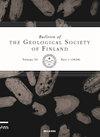Growth of the Archean sialic crust as revealed by zircon in the TTGs in eastern Finland
IF 1.3
4区 地球科学
Q2 GEOLOGY
引用次数: 0
Abstract
U–Pb age determinations on zircon from granitoids in the Archean of eastern Finland were conducted using the SIMS, LA-ICP-MS and TIMS techniques, with an emphasis on low-HREE granitoids. The oldest rocks in the Fennoscandian Shield are 3.4–3.5 Ga. Several samples were collected close to these rocks, but none of the samples were as old, indicating that the oldest rocks are only small, possibly allochthonous fragments in the Neoarchean bedrock. Some tonalite–trondhjemite–granodiorite (TTG) samples yielded homogeneous 2.72–2.73 Ga zircon populations, and in these samples, the initial εNd was also close to the depleted mantle (DM) values. However, several granitoid samples with a main zircon population of 2.7–2.8 Ga had 2.9–3.2 Ga grains or inherited cores, and in some samples, all grains were of 2.9–3.0 Ga. In these samples, the εNd value was also close to zero or slightly negative. These features suggest that apart from the juvenile Neoarchean magmas, the abundance of reworked 2.9 Ga material is considerable in the Archean crust, which developed during successive juvenile magmatic inputs that melted and assimilated the older sialic crust. The low- HREE geochemical character of granitoids has no correlation with their age, with the low-HREE granitoids yielding an age span of 2.72–2.98 Ga.芬兰东部ttg中锆石揭示的太古宙硅质地壳生长
采用SIMS、LA-ICP-MS和TIMS技术对芬兰东部太古宙花岗岩类锆石进行了U-Pb年龄测定,重点研究了低三ree花岗岩类锆石年龄。Fennoscandian地盾中最古老的岩石是3.4-3.5 Ga。在这些岩石附近收集了几个样本,但没有一个样本是如此古老,这表明最古老的岩石只是小的,可能是新太古代基岩中的异域碎片。部分闪长-闪长-花岗闪长岩(TTG)样品的锆石种群均为2.72 ~ 2.73 Ga,初始εNd也接近于贫地幔(DM)值。然而,部分花岗岩类样品的主要锆石种群为2.7 ~ 2.8 Ga,具有2.9 ~ 3.2 Ga的颗粒或继承核,部分样品的所有颗粒均为2.9 ~ 3.0 Ga。在这些样本中,εNd值也接近于零或略为负值。这些特征表明,太古宙地壳中除了年轻的新太古代岩浆外,还有大量的2.9 Ga重加工物质,这些物质是在连续的年轻岩浆输入过程中形成的,这些岩浆熔化并同化了古老的唾液质地壳。花岗岩类低三元素地球化学特征与年龄无关,低三元素花岗岩类的年龄跨度为2.72 ~ 2.98 Ga。
本文章由计算机程序翻译,如有差异,请以英文原文为准。
求助全文
约1分钟内获得全文
求助全文
来源期刊
CiteScore
1.30
自引率
0.00%
发文量
5
审稿时长
>12 weeks
期刊介绍:
Bulletin of the Geological Society of Finland (BGSF) publishes research articles and short communications in all branches of geosciences. Contributions from outside Finland are welcome, provided that they contain material relevant to Finnish geology or are of general interest.

 求助内容:
求助内容: 应助结果提醒方式:
应助结果提醒方式:


